The Dessins Denon: Reframing Art Spoliation and the Spoliator in Napoleonic France
by Nancy Caron KarrelsNancy Caron Karrels is a specialist in nineteenth-century French art and cultural property. Her publications and exhibitions include “Commemorating Spolia in Napoleonic France” for the edited volume Nouveaux regards sur les saisies patrimoniales en Europe à l’époque de la Révolution française (2021); and Provenance: A Forensic History of Art at Krannert Art Museum (2017). Her PhD dissertation (2022) on paintings, works on paper, and objets d’art created to celebrate and memorialize art confiscations during the Napoleonic era was supported with funding from the Fulbright Program (France) and the Social Sciences and Humanities Research Council of Canada. She holds JD and BCL degrees.
Email the author: nancy[at]nancykarrels.com
Citation: Nancy Karrels, “The Dessins Denon: Reframing Art Spoliation and the Spoliator in Napoleonic France,” Nineteenth-Century Art Worldwide 22, no. 2 (Autumn 2023), https://doi.org/10.29411/ncaw.2023.22.2.4.
This work is licensed under a Creative Commons Attribution-NonCommercial 4.0 International License  unless otherwise noted.
unless otherwise noted.
Your browser will either open the file, download it to a folder, or display a dialog with options.
This article is based on a paper presented at the Association of Historians of Nineteenth-Century Art’s 2023 Graduate Student Symposium in Nineteenth-Century Art. It was awarded the Dahesh Museum of Art Prize for the Best Paper, a gift from the Mervat Zahid Cultural Foundation.
Scholarly Article|Appendix
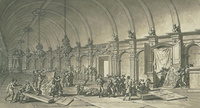
Studies of the systematic art looting perpetrated by French forces across Europe during the Revolutionary Wars (1792–1802) and Napoleonic Wars (1802–1815) often call on a particularly powerful image to illustrate their subject, namely The Madonna with Saint Jerome Is Delivered to French Commissioners in Parma (hereafter Parma Academy), a drawing attributed to the French painter Charles Meynier (1768–1832) (fig. 1). It reimagines a visit paid by French agents to seize artworks from the Parmese art academy during the Italian campaign of 1796–97. Probably made around 1807, the pen-and-pencil drawing pictures an early episode of art confiscation ordered directly by the young General Napoléon Bonaparte (1769–1821).[1] Some two dozen men are removing priceless artifacts, including beloved Renaissance paintings, from their places in the long gallery and readying the objects for shipment to Paris. A brazen celebration of France’s so-called cultural conquests, Parma Academy memorialized a type of action that was considered controversial during the revolutionary decade but was largely dismissed as routine under the First Empire.
If the drawing is familiar, the larger project to which it belongs is more obscure, particularly outside France. Meynier’s drawing is part of a corpus of more than three hundred drawings commissioned beginning in 1805 by Dominique-Vivant Denon (1747–1825), the Musée du Louvre’s first director, for a series of fine-art prints about Napoleon’s military conquests. Known informally today as the Dessins Denon, the drawings were never engraved and were eventually dispersed among a few institutions and an unknown number of private collections.[2] This article examines a curious subset of thirteen drawings—less than 5 percent of the Dessins Denon, but not an insignificant number—that depict the French looting of art collections in Italy, Germany, and Austria around the turn of the nineteenth century.[3]
The article begins with a simple question: Why did the Louvre’s director commission scenes of art theft for an important volume of prints ostensibly about Napoleon’s military victories? Examining these images of forcible art seizures alongside Denon’s correspondence to Napoleon and to others, I posit that Denon devised this corpus of art about art looting as an orderly articulation and contextualization of his professional identity and methodology of collecting against the backdrop of Napoleonic conquest. More explicitly, I argue that Denon commissioned drawings about art confiscation for two purposes: to immortalize his own role in the cultural conquests, and to legitimize art looting as a respectable approach to collecting for one of Europe’s most celebrated art museums. He intended the spoliation imagery—many examples of which featured his likeness—to burnish his legacy alongside that of Napoleon and his most decorated generals and to transform wartime cultural property theft into a civilized, post-Enlightenment pursuit worthy of remembrance together with the Italian campaigns and the French victory at Austerlitz.[4]
The Dessins Denon remain virtually unexamined as a deliberate and unified enterprise. Claudine Lebrun-Jouve, whose important archival research and connoisseurship most recently brought to light this fascinating project, identified many of the drawings and attributed them to specific artists, including Constant Bourgeois (1767–1841) and Nicolas Antoine Taunay (1755–1830).[5] Marie-Anne Dupuy-Vachey attributed several sketches in the series to Denon himself in the course of her substantial studies on Denon.[6] Others have included the project in discussions of Denon’s broader career or his work with artists who contributed to the Dessins Denon, such as Benjamin Zix (1772–1811) and Meynier.[7] Aside from these studies, scholars have customarily extracted individual images of looting from the series to illustrate historical accounts of the Napoleonic era, but have neglected to discuss their role in Denon’s print project. This study attempts to fill some of the lacunae in scholarship by considering the meaning of spoliation-themed drawings in the Dessins Denon endeavor.
Any potentially exhaustive study of the Dessins Denon is hampered by a lack of documentation attached to the project, which is known principally from surviving drawings and scant references in correspondence between Denon and Napoleon or the imperial household. Lebrun-Jouve traced the project’s hazy contours and helped illuminate the authorship of several drawings, but the total number of illustrations created for this project still remains unknown.[8] No prospectus was ever published. Denon maintained no inventory of assigned or delivered drawings, and little correspondence exists between Denon and the artists involved. Denon left no indication of the number of spoliation scenes he intended to engrave and publish in the total of two hundred prints projected for his recueil (edited series of original prints), and so we cannot confirm how prominent a place the art confiscations would have occupied in the final publication.
There are, furthermore, no precise criteria for assigning works to the corpus of the Dessins Denon. The full number in Denon’s possession was dispersed after his death and reached museums and collectors in piecemeal fashion. Previous scholars have employed the term Dessins Denon to denote the 189 works that passed from the Comte de Durante collection (acquired by succession from Denon’s nephew) to the Louvre in 1896 plus a second body of drawings acquired by the Musée du Château de Versailles in 1933 via an agent recorded only as “Schoeller;” most of these were later transferred to the Louvre.[9] Today, the Louvre recognizes 355 drawings from this project in its graphic arts collection. In addition to the Louvre and the Château de Versailles, institutions that hold works from the Dessins Denon include the Bibliothèque Nationale de France in Paris, the British Museum, and the Musée Vivant Denon in Chalon-sur-Saône. An unknown number of original drawings are probably still unaccounted for, an assumption supported by the unexpected appearance at a Toulouse auction house in 2019 of twenty-eight drawings and one notebook of twenty-five sketches. These hitherto-unknown sheets, representing the 1806–7 French campaigns (including incidents of art looting) in Prussia and Poland, were made by Denon’s protégé, the Alsatian artist Benjamin Zix, and other artists known to have contributed to the project.[10] The thirteen looting images discussed in this study unquestionably form part of the corpus in question, judging by the subjects and locations represented by the artists involved (most images are unsigned), and by tracing Denon’s travels through his correspondence. A parallel aim of this study is thus to restore the spoliation subset of drawings to its proper art historical context.
“A work on the Italian and German campaigns”
By all accounts, Denon devised the project himself and was absorbed in its elaboration nearly until the fall of Napoleon. As first consul, Bonaparte had appointed Denon—a worldly and accomplished artist, diplomat, curator, author, and cultural critic—to the post of the Louvre’s first director in 1802. One of Denon’s earliest undertakings was to change the museum’s name from Muséum Central des Arts de la République (Central Museum of the Arts of the Republic) to Musée Napoléon.[11] Between 1802 and 1815, Denon assumed an expansive role as France’s de facto minister of fine arts, which gave him broad authority over the fine arts in Paris and throughout France: he reenvisioned and expanded the museum space, conceived of artworks for public buildings, assigned commissions to artists, and oversaw imperial luxury-goods manufactories, such as the Sèvres porcelain and Gobelins tapestry factories. More broadly, Denon was charged with nothing less than elevating French painting to the heights it had reputedly occupied in the days of Nicolas Poussin (1594–1665), Eustache Le Sueur (1616–55), and Charles Le Brun (1619–90).[12] And more than anyone else, Denon helped to elaborate a cultural policy designed to celebrate, legitimize, and commemorate Napoleon’s victories at home and abroad, leading to the production of countless propaganda images in all manner of media.[13] Denon also managed the Louvre’s ballooning art collection and orchestrated the persistent spoliation of artworks from the finest galleries of France’s conquered enemies. Ever mindful of Napoleon’s legacy and his own reputation, he would commission several works in various media to memorialize the French spoliation of European treasures.[14] The Dessins Denon operated at the intersection of these numerous and overlapping concerns.
As early as 1803, Denon expressed to First Consul Bonaparte a desire to trace the former general’s footsteps “to gather information and take notes of the events from your past for posterity.”[15] Denon more clearly articulated his intentions in 1806 in a formal proposal to Napoleon, in which he shared that he had begun to gather drawings of monuments Napoleon might have encountered in Italy and Germany to “illustrate and commit to memory the countries [Napoleon] traversed in his military marches.”[16] Keen to receive official authorization, he attached a draft imperial decree outlining the production of an elaborate recueil of original fine-art prints for which Denon would be “charged with the execution of drawings and engravings for a work on the Italian and German campaigns.”[17] The attached budget outlined costs spread over three years for the various elements of the endeavor: foreign travel for Denon and two draftsmen; two hundred finished drawings at one hundred francs each; two hundred copperplate engravings at two thousand francs apiece; scholarly essays; fine paper for six hundred print runs; and cartonnage (cardboard packaging or possibly binding) for the finished editions.[18] To cover his own expenses, Denon proposed a monthly stipend for himself.[19] The imperial government approved the three-year project, and Denon’s draftsmen journeyed to the sites of recent French battles and celebrated events (often alongside the peripatetic director himself, who contributed several drawings to the collection) to make perfunctory sketches of landscapes and local monuments in pencil or pen.[20] Back in Paris, Denon commissioned artists to make these into finished drawings with the objective of engraving the suite.
In the end, Denon’s project never progressed beyond the first stage dedicated to travel and drafting. For just as Denon exhibited an inexhaustible zeal for collecting art—both for his personal collection and for the museum’s—he displayed a single-minded obsession with the accumulation of sketches and finished drawings for the Dessins Denon, none of which reached the studios of imperial engravers.[21] In 1810, Napoleon stopped financing the interminable endeavor, but Denon continued to bankroll draftsmen from his own funds for at least three more years.[22] Most of the drawings remained with Denon’s estate at his death in 1825.[23]
The Print Album (Recueil d’estampes)
An important part of rebuilding the Dessins Denon’s context is recognizing the function of the finished drawings: they were to be translated into luxury prints for a well-heeled clientele. As many scholars have demonstrated, eighteenth-century France witnessed the significant rise of the fine-art print.[24] Begun at the turn of the nineteenth century, the Dessins Denon project represented a foray into a newly fashionable subgenre of engraving, namely the recueil of original prints about recent events of national importance. Intaglio prints from contemporary history proliferated in the wake of the French Revolution, when politicians, publishers, and artists alike mobilized the genre to spread propaganda, record momentous events, and provide a living for draftsmen and engravers.[25] The unique advantage of copperplate engraving—its ability to strike hundreds or thousands of quality images from a single plate for wide distribution—made the medium particularly suitable for spreading revolutionary propaganda. Even as the French Revolution devastated traditional patronage for painters, sculptors, and luxury artisans, engravers discovered that their skills remained in demand at the end of the eighteenth century.
Denon’s venture took shape in the wake of the wildly successful publication of the Collection complète des tableaux historiques de la Révolution française (Complete collection of historical pictures of the French Revolution) (1791–94) and during production of the Tableaux historiques des campagnes d’Italie depuis l’an IV jusqu’à la Bataille de Marengo (Historical pictures of the Italian campaigns from Year IV to the Battle of Marengo) (1806), each of which highlighted French political and military achievements and featured illustrations by leading artists, including the painter Carle Vernet (1758–1836) and the engraver Jean Duplessis-Bertaux (1750–1818).[26] As early as 1799, an advertisement seeking subscriptions to Tableaux historiques des campagnes d’Italie promised essays from eyewitnesses to accompany each print, intended to lend an apparent degree of veracity to the actions portrayed in the engraved images.[27] Denon would borrow this strategy for his recueil. He would also focus on military achievements. By way of example, Denon’s itinerant draftsmen produced at least seven images to commemorate the January 14, 1797, French victory at Rivoli against Austrian forces. Among these were five preliminary sketches, including Taunay’s View of Rivoli (fig. 2), a small pencil sketch of the valley and mountains surrounding the Piedmontese town, and two more finished illustrations, most notable among them Taunay’s Battle of Rivoli, July 14, 1797 (fig. 3), a black ink and charcoal drawing with gray wash depicting marching soldiers and mounted officers advancing through the alpine landscape toward a smoke-filled battlefield with Rimini’s church towers pictured in the far distance. What would ostensibly make Denon’s project distinct from those that preceded it would be the inclusion of cultural achievements alongside martial victories; chief among these were representations of instances of art looting—the very events that would grow the Louvre’s collection and Denon’s prestige as its director. The Dessins Denon’s iteration of the leitmotif of art spoliation in no fewer than thirteen drawings was a clear innovation in an era that had, prior to 1796, produced very few interpretations of the theme.
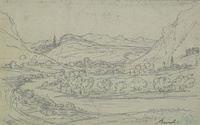
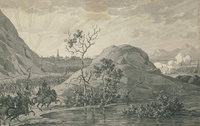
Denon had every reason to believe in the Dessins Denon’s eventual triumph because he had already published a successful print recueil. In 1802, he had issued the extraordinarily well-received Voyage dans la Basse et la Haute Égypte pendant les campagnes du General Bonaparte (Travels in Lower and Upper Egypt during the Campaigns of General Bonaparte; hereafter Travels in Egypt) after serving as a member of the Commission for the Sciences and Arts in Egypt, a roughly 150-person-strong team of scientists, naturalists, engineers, and artists that accompanied French expeditionary forces in Egypt and Syria under General Bonaparte in 1798–1801.[28] Filled with exotic scenes of pyramids, obelisks, harems, and hieroglyphs, and seaside cityscapes framed by palm trees, Travels in Egypt was almost immediately translated into English and became an international bestseller even in Great Britain, despite the country’s uneasy relations with France stemming partly from, ironically, the conquest of Egypt.[29] Travels in Egypt featured one volume of 241 engraved plates made from drawings by Denon as well as a second volume of text in which Denon chronicled his journey through North Africa, described the local culture, and recorded the movements of French military units. Denon’s images of an unfamiliar land had a tremendous impact in France and abroad, reaching an eager audience seven years before the publication of the first tome of the Description de l’Égypte (Description of Egypt), the official twenty-three-volume series compiled by the Commission for the Sciences and Arts in Egypt.[30] Travels in Egypt’s success positioned Denon as a recognized cultural expert and attached his name to that of Bonaparte, to whom the book was dedicated and who would soon name Denon director of the Louvre. Just a few years later, the continued success of Travels in Egypt undoubtedly encouraged Denon’s elevated expectations concerning the likelihood of a similar reception for the Dessins Denon.[31]
Denon’s Travels in Egypt serves as an important point of reference for understanding the Dessins Denon, because it articulated Denon’s philosophical approach to illustrating and describing locations and events, namely the profound conviction that physical proximity and beholding equaled authority. He narrated his scientific mission in the style of an embedded war correspondent—“I was at war,” he wrote without irony—with essays that framed his images as truthful testimony of direct, personal experience.[32] He reported sketching in the thick of the action, “more often than not on my knee, or standing up, or even on horseback.”[33] This manner of writing asserted Denon’s status as an eyewitness to the lieux (sites) he committed to paper and to the events the French press reported during the Egyptian campaign. Lest the point go unnoticed, he took pains to point out his devotion to accuracy and its value to his audience of citizens and scholars.[34] To lend further credence to the veracity of his visual reporting, Denon acknowledged certain lacunae in his accounts, admitting to “having seen a hundred things while a thousand others escaped me.”[35]
In 1805, Denon similarly emphasized the importance of the eyewitness account to gain Napoleon’s support for the recueil of the latter’s conquests. Arguing that the project was part of his broader responsibilities at the Louvre and vital to the promotion of Napoleon’s legacy, Denon insisted on traveling to previously conquered battlefields, cities, and monuments to personally behold them. In a letter to the emperor, Denon lamented his inability to truly understand and accurately describe the triumphant scenes he assigned to artists for state projects in the absence of firsthand knowledge. “I have written up as best I could that which Your Majesty dictated to me with both wisdom and speed,” he wrote, “but not having the good fortune to have been a witness to the facts . . . I find myself reduced to general knowledge of a misguided nature that leads me to abandon in every instance a work that I cannot believe to be worthy of you.”[36] Pressing the point, Denon insisted that “[recounting the history] of our heroes requires . . . a sort of ensemble dramatique [dramatic ensemble] that can only be known and expressed by eyewitnesses or by the heroes themselves.”[37] He further claimed that none but a témoin (witness) could fully appreciate events as they happened; that seeing the sites of past feats would allow him to acquire a real connaissance (knowledge) of them; that his great attention to details assured their transmission with précision (precision); and that artists fervently wishing to produce work pertaining to Napoleon’s campaigns demanded views prises sur les lieux (recorded on site).[38] For Denon, the notions of witnessing—or the appearance thereof—and verity were indissociable. As he would relate to the emperor in 1807, upon viewing the Dessins Denon, “one will see and one will believe the history of Your Majesty.”[39] In effect, Denon aspired to provide testimony for the conquests in the absence of actually witnessing them firsthand, an ambition that captured the fiction of the contemporary historical genre whereby artistic representations of current events came to stand as historical evidence of the event itself when seen by enough viewers.[40] But contrary to the ideals of truth and transparency he professed, Denon’s rhetoric of témoignage (witnessing) obscured the nature of a project destined to produce a heavily mediated visual mythology of Napoleonic glory.[41]
Revisiting Parma Academy
We see this plainly in drawings of the Parma Academy of Art, which represents the earliest incident of art looting recorded in Denon’s corpus. French officials had greedily deliberated the event since at least May 23, 1794, when members of a monuments committee recommended that France should seize specific treasures from all future conquered lands as a just indemnity for war costs and to secure the gains of the Revolutionary Wars.[42] French forces would indeed subdue Parma in flagrant violation of the duchy’s neutrality in the spring of 1796.[43] The Duke of Parma, Ferdinando di Borbone, concluded an armistice with Bonaparte on May 9 and ceded twenty paintings of Bonaparte’s choosing, marking the first instance in modern history in which a military leader, supported by his government but acting largely independently, demanded reparations of art in an armistice agreement.[44] (Writing art as reparations into this type of formal armistice would fall by the wayside as French victories swelled and art seizures became standard.) The same day, Bonaparte wrote to Paris promising to send, “the most beautiful paintings by Correggio, among others a Saint Jerome that is said to be his masterpiece.”[45] Although the seizures in Parma predated Denon’s tenure at the Louvre, the proceedings would form the cornerstone of Napoleon’s status as a patron of the arts and prompt a collection-building strategy whose vast scale would soon demand the appointment of Denon as its masterful overseer.[46] In other words, it is not surprising Denon commissioned drawings for an art seizure in which he had no involvement, because the looting of Parma foreshadowed his professional rise; conversely, the art confiscations of 1794 in Belgium and Germany were germane to neither Denon’s nor Napoleon’s history, and so Denon apparently excluded them from his opus.
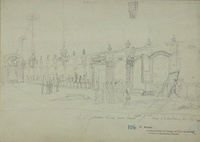
The preparatory pencil sketch made before the separate pen drawing of the Parma Academy was probably made around 1805 (nearly a decade after the events it represents), when Denon made two trips to Italy with one or two draftsmen—Hippolyte Lecomte (1781–1857) and/or Bourgeois—and stopped in Parma before returning to Paris.[47] The sketch, attributed by the Louvre to Meynier, illustrates the architectural details of a large gallery with the hint of a vaulted ceiling and an array of decorative and sculptural elements (fig. 4).[48] Baroque arches line the gallery and busts perch atop the cornice as if surveying the activity. The dark lines of a lone corbel incongruously interrupt the curve of faintly drawn vaults along the upper right quadrant of the drawing. Heavy chandeliers hang from the central axis of the room, lighting the way to the suggestion of an elevated niche at the far end of the hall. Unlike most initial sketches in this series, the Parma Academy includes figures in action: men who moments earlier had removed Antonio da Correggio’s (ca. 1489–1534) Madonna of Saint Jerome (1528; Galleria Nazionale di Parma) from its protective enclosure now lean the panel vertically so that attentive observers can appreciate it at eye level, and a secondary group of figures stands and gestures in the background.
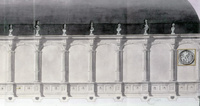
Denon was probably in Parma when he ordered the in-situ sketch of the Parma Academy and could testify to the scene’s setting. He was not, however, present during the actual 1796 seizure of the academy’s art collection, and instructions to his draftsmen as to the action taking place within the setting could only have been informed by secondhand accounts. Meynier’s finished ink drawing added architectural details to help viewers identify the composition’s precise location and subject. He populated the drawing with a far greater number of figures than the sketch, doubled the sculptural elements, added a detailed ducal throne, and inserted a second major painting removed from Parma, Bartolommeo Schidone’s (1578–1615) Entombment of Christ (ca. 17th century; Musée du Louvre).[49] The packing crates are clearly labeled with the treasures they will soon contain, and the source of those treasures: “Jérôme du Corrège de Parme” and “Du Schidoné à Parme.” A period drawing of unknown authorship reveals just how faithfully Meynier replicated the design of the gallery, inaugurated in 1767, from the vaulted ceiling and ornate capitals to the busts set atop the cornice (fig. 5).[50] The ducal throne and its canopy, situated on the elevated niche at the north end of the gallery, referenced Parma’s sovereign, who traditionally attended the academy’s annual prize-giving ceremonies; the drawing’s empty seat served as a powerful symbol of the absence of its erstwhile ruler after the fall of Parma. The artist correctly situated the Correggio altarpiece, considered the most important work of the collection, in a large cabinet in the gallery. Altogether, Meynier’s architectural backdrop is a near-exact replica of the Parma Academy of Art in 1796. It exemplifies the Dessins Denon’s commitment to accuracy in rendering geography and built environments, qualities essential for Denon’s system of distraction and dissimulation in which he provided just enough factual precision to cloak the extent to which his drawings filtered the past.
Following Denon’s lead, Meynier took liberties relating events in Parma. Though written sources provide an incomplete account of the removal and packaging of artworks from the academy, we can surmise that probably Jacques-Pierre Tinet, a little-known painter already attached to the French army in Italy, made an initial selection of artworks for confiscation, and crated those objects, and then sent them to a storage facility in the region.[51] A few days or weeks later, a small number of experts, newly appointed to the Commission for the Arts and Sciences in Italy, examined the contents of the crates, approved three-quarters of Tinet’s hoard for shipment to France, and left five paintings behind.[52] The full commission was certainly not in Parma overseeing the removal of artifacts from the academy, as Meynier’s large group of participants suggests, and what is more, the military officers who favored bicornes during this era would have been far too occupied with the rapid, forward movement of French forces into Italy in the late spring and summer of 1796 to assemble in these numbers for an event so secondary to the war at hand. Yet Denon elected to have Meynier represent these specific signifiers of discipline and authority, perhaps partly to silence critics who had in 1796 decried France’s art confiscations in Italy as ignorant and barbaric.[53] Instead of illustrating the amateurish efforts of the inexpert Tinet, Meynier composed a scene characterized by orderliness, expertise, and power.
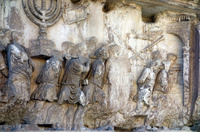
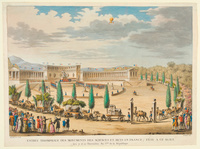
Meynier’s portrayal of the Parma Academy diverged from the Western art historical tradition of presenting plundered art as spolia victoriae—the spoils of victory—a custom exemplified by The Spoils of Jerusalem, a bas-relief panel dated to 81 CE that adorns the Arch of Titus on Rome’s Capitoline Hill (fig. 6).[54] The frieze illustrates the most important war trophies, among them a golden menorah, seized by Roman forces under the future Emperor Vespasian and his son, Titus, during their successful military campaign in Judea. The visual convention of spolia victoriae persisted in postrevolutionary France, for example in Abraham Girardet’s (1764–1823) and Pierre-Gabriel Berthault’s (ca. 1748–ca. 1819) Triumphal Entry of Monuments of Science and Art in France (ca. 1802) (fig. 7), the most frequently reproduced image of the French spoliation of Europe’s treasures.[55] Created for Collection complète des tableaux historiques de la Révolution française, the print by Girardet and Berthault commemorated the formal procession of spoliated artifacts through Paris during the Festival of Liberty held on July 27–28, 1798. It captured crowds of onlookers gawking at a seemingly endless parade of carts transporting artworks and exotic curiosities across Paris, while government officials assembled to receive the war booty on behalf of the French Republic. With its emphasis on collections care, the Parma Academy stood in stark relief to the long pictorial heritage of memorializing art pillaging in wartime. The distinction suggests Denon deliberately created a new visual tradition of art confiscations to dissociate French actions from the violence-tinged martial plundering of the past.
Had the Parma Academy sketch and drawing been the only images with looting themes that Denon commissioned for the larger Dessins Denon project, they would have, at most, represented a brief interlude from the more numerous episodes of martial triumph. However, there exist too many additional illustrations of spoliation for their presence to be merely anecdotal. Over the next few years, Denon compiled an assortment of analogous images from different sites of French conquest and often inserted himself into the illustrations as an active participant. In scenes of French agents scrutinizing artifacts, fabricating custom crates to transport priceless artworks, and creating order from disarray (never mind that the disarray stemmed from the French military incursion), he would go even further in pronouncing a new approach to collecting for a national, encyclopedic museum and assertively positioning himself as the architect of this innovative method.[56]
A Methodology of Collecting
Denon would fully elaborate his thematic series about art spoliation after Napoleon’s armies turned eastward in the years following the proclamation of the First Empire and Napoleon’s assumption to the imperial throne in 1804, a period in which Denon was frequently called on to commemorate military conquests in the visual arts. In Germany and Austria, Denon personally followed the front lines of the French army into cities defeated in 1806 and 1807 in order to oversee the selection and dispatching of artworks from the collections of regional rulers. Denon’s appetite for art looting in these excursions became so legendary that Napoleon’s entourage of soldiers allegedly derided Denon as a huissier-priseur—a bailiff or debt-collector of sorts—behind his back.[57] Contemporary accounts of the eastern campaigns corroborate Denon’s active participation in the seizure of artworks: the Gazette de France reported on Denon’s mission in Vienna in early 1806,[58] and the Journal de l’Empire noted the departure of a large convoy transporting objects acquired by Denon from the palace of the Prince-Elector of Hesse, including prized antique sculptures and paintings by artists such as David Teniers (1610–90), Rembrandt van Rijn (1606–69), and Claude Lorrain (1604–82). A report from December 2, 1806, described Denon’s methodical tours of Prussian royal properties in which he identified objects “worthy of adding to France’s riches,” then recounted a visit paid by Denon’s deputy to Sans-Souci, the summer palace of Frederick the Great (1712–86), to order the removal of several statues.[59] At times, the press related the technical effort attendant to spoliation, such as when the Journal de l’Empire proclaimed, “The carpenters of Potsdam work without rest to make the necessary cases to package these valuable items.”[60]
Denon’s voice was evident in articles that boasted of the efficiency of operations and the professional standard of care brought to the foreign treasures. As Elaine Williamson has noted, Denon often interceded directly with newspaper editors to request the insertion of certain texts, and moreover, he was adept at exploiting different genres of journalistic discourse.[61] Denon’s published notes from the field in Prussia, presented as objective reportage, corroborated the Dessins Denon’s visual accounts of events in Germany and Austria. Had the drawings ultimately been engraved and printed in a recueil, the news snippets and prints together would have functioned as mutual confirmations of truthfulness when read intertextually.[62] No stranger to the authenticating effect of both historical imagery and the published word, Denon in all likelihood expected these to validate his responsibility for, and approach to, the enrichment of the French national art collection.
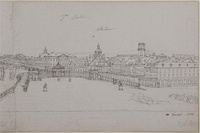
We owe much of our understanding of the art confiscations in Germany and Austria to Denon’s protégé, Zix, who is best known for drawing Napoleon and Marie-Louise’s marriage cortege in the Louvre galleries.[63] Trained in drawing and engraving in Strasbourg, Zix developed his skills as a military painter while serving with France’s eastern armies during the French Revolutionary Wars.[64] Zix produced dozens of images, from pencil and ink drawings to sepia washes, on trips behind the front lines with Denon between 1805, when the two artists met in Zix’s native Strasbourg, and 1811, when Zix died from a fever in Denon’s presence while working on the Dessins Denon in Italy. Zix often sketched in pen and has a distinctive, straightforward style, as we see in his sketch of Kassel’s monuments (fig. 8), a quality that facilitates the attribution of his name to unsigned drawings in the series.
Much more personal than Meynier’s Parma Academy, owing to his actual presence at the events he depicted, Zix’s renderings of art looting shine a spotlight on the intricacies of French operations. The most striking aspects of the drawings are the intimacy of the settings and the identifiability of the figures.[65] In contrast to the faceless officers populating Meynier’s Parma scene, Zix’s portrayals of French art confiscations in Berlin and Kassel include portraits of Denon, his secretary (acknowledged in the historical record only as “Perne,” to the frustration of Denon’s biographers), and even Zix himself, who, as a native German speaker, also acted as Denon’s translator during these expeditions.[66] Perhaps this personalized perspective grew from the camaraderie that developed between the seasoned Denon and the young Zix early in their working relationship, prompting Zix to write to his parents in the summer of 1806, “To me, Mr. Denon is the best of all acquaintances: he likes me very much and I always have plenty to do for him.”[67] Zix remained Denon’s acolyte until his premature death and invariably captured Denon in a sympathetic light, often caught up in moments of quiet contemplation. In several drawings, all of which are discussed below, Zix pictured Denon casting a knowledgeable eye on his reluctant host’s cultural riches while thoughtfully considering each artifact as a potential addition to the Louvre’s collection. In other scenes, Denon performed his erudition for visiting notables in a gallery he would soon raid. Many of these portrayals were not far removed from what was described in the testimonies of contemporary witnesses to Denon’s visits, however troubling they deemed his goals: several attested to the director’s courtesy and professionalism in discharging his duties.[68]
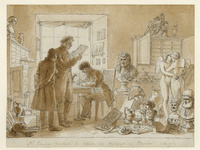
Each drawing in Zix’s spoliation series is an argument in support of Denon and his mission. Monsieur Denon Visiting the Cabinet of Antiquities, Berlin, for example, highlights the director’s discernment (fig. 9).[69] In a room brimming with ancient and modern busts, vases, paintings, coins, and objets d’art, Zix pictured Denon standing still while examining the contents of a frame that likely contained carved gemstones or medals. Amid the disarray of priceless objects that suggest nothing so much as a ransacking of the imperial collection, Denon’s efficient secretary sits at a desk drafting an inventory as Zix leans into Denon, who enacts his role as a connoisseur of precious treasures.[70] In the clutter, we can identify a Roman copy of the Greek sculpture Cupid and Psyche (now in the Altes Museum in Berlin) and several life-size Roman busts; several of these would find their way into another of Zix’s drawings chronicling the arrival of confiscated artworks at the Louvre.[71] Impervious to the disarray around him, the director serenely surveys his booty as if standing in his own living room: he has effectively taken ownership of the conquered enemy’s display space in addition to the enemy’s art.
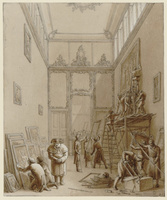
Zix followed Denon to Kassel where, in early 1807, Denon reported having gathered an “ample harvest” of artworks in the course of an expedition whose success Bénédicte Savoy ascribes in part to Denon’s discerning eye, elegant manners, and celebrity, even among the defeated Germans.[72] Zix’s ink drawing Seizure from the Kassel Gallery—just one of several made in that city—portrays workmen competently removing paintings from the gallery of the newly divested William I, Prince-Elector of Hesse (fig. 10). In this composition, a supervisor oversees the conveyance of a large frame recently relieved of its canvas and directs a group of men to unhook Peter Paul Rubens’s (1577–1640) Mars and Venus, the largest (and arguably most important) painting in the gallery, from the wall.[73] A group of laborers constructs a crate—one of nineteen required to transport the more than three hundred works Denon removed from Kassel—with a hacksaw in the right foreground.[74] Set apart from these bustling operations are Denon and Zix, quietly riveted by a painting in the left foreground as a corpulent caretaker hovers behind them. In this image, Zix has positioned the physical removal of artifacts in the shadows while shining sunlight on Denon’s judgment and art appreciation. Seizure from the Kassel Gallery plainly demonstrates the director’s method of spoliation as collecting: there is expertise in the figure of Denon; authority in the persons of the guard and the bicorned man directing the workers; collections care in building a bespoke crate and in the removal of Rubens’s masterpiece from the wall by a team of handlers; and a small measure of restraint represented by the paintings left on the gallery walls. This single drawing accomplishes Denon’s twin goals of promoting his professional legacy and transforming perceptions of wartime pillaging.
Four years ago, three previously unknown illustrations by Zix of Denon engaging in spoliation—two pencil sketches, both bearing the inscription “Musée de Cassel,” and an ink drawing with sepia wash—surfaced on the French art market, helping us reconstruct a more complete visual record of the French spoliation of Germany.[75] In the first of these sketches, The Kassel Museum (fig. 11), Zix captured the architectural and sculptural elements of the Museum Fredericianum in Kassel and mapped out its perspective in a simple line drawing of the gallery, characterized by Doric columns, a flat ceiling, intricate mouldings, and an enfilade of arched doorways. Unlike the lines drawn freehand in the anonymous Parma sketch, the architectural lines of Zix’s Fredericianum sketch are straight and precise, suggesting he had sufficient time to make an exact likeness on site. A second sketch with the same title (fig. 12) offers a hint of the notables and laborers who would populate the final drawing as well as the mechanisms for the removal of Kassel’s heavy marble sculptures, of which Denon’s task force seized twenty examples during this visit. Like so many of the Dessins Denon, these preparatory sketches in Zix’s clear drafting style profile a distinct location with an exactitude meant to convey trustworthiness. And in this instance, we can look to a late nineteenth-century photograph of the Museum Fredericianum (fig. 13) to confirm Zix’s remarkable accuracy in service to Denon’s mission.
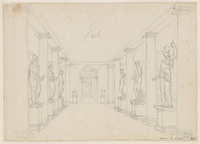
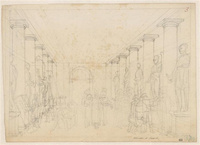
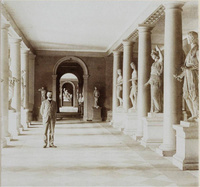
Zix’s finished black-ink drawing with brown wash, Seizure of Sculptures from the Museum in Kassel, with Dominique-Vivant Denon at Center (fig. 14), combines the precise setting with the dynamic work of art looting by skilled workmen in a complex scene that can easily be imagined as a full-scale history painting starring the Louvre’s ambitious director. The artist shows a flurry of activity unfolding across almost every square foot of the gallery floor: workmen competently build cases, remove treasures, and crate their spoils for transport as dignitaries observe the goings-on with pride or dismay. On the floor are empty boxes, sculpted busts, and tools useful to the operation at hand. In the thick of it stands Vivant Denon, sporting a bicorne and pointing confidently towards a large stone figure of Hygeia being lowered by several straining men operating a pulley in the right foreground. There is no doubt Denon is the hero of this tableau. His pose nearly imitates that of his sovereign about to recapture Italy from Austrian forces in Jacques-Louis David’s (1748–1825) famous equestrian portrait from 1801 of Bonaparte on the Saint-Bernard Pass (fig. 15), but rather than pointing toward victory in a military campaign Denon points towards victory in his professional campaign to acquire Europe’s most extraordinary cultural treasures for Europe’s most extraordinary museum. Put simply, it is a portrait of Denon as cultural conqueror achieving greater glory for the French Empire, a civilian counterpart to the warriors leading the Grande Armée on Europe’s battlefields. Its focus on Denon’s management of a large-scale operation and on his conviviality—he is simultaneously engaging with a small audience as he gestures towards France’s latest trophy—complements the drawings of Monsieur Denon Visiting the Cabinet of Antiquities, Berlin and Seizure from the Kassel Gallery, which each highlight his erudition as a collector. Together, Zix’s views of Denon as a self-possessed museum professional transmit awareness and appreciation of Denon’s role in the confiscation of art in Germany and the growing sophistication of French art-looting operations under his capable leadership.
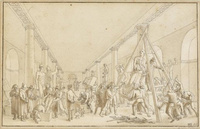
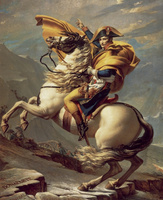

Similarly, Zix deftly united a number of elements from Denon’s spoliation narrative in a particularly captivating representation of foreign pillaging operations, The Packaging of Paintings on the Terrace of the Belvedere in Vienna (fig. 16), a drawing made in 1810 in collaboration with Bourgeois. Denon reported in detail on this episode to Jean de Cambacérès, Napoleon’s arch-chancellor, writing that he had selected three hundred paintings from Vienna, “among which 100 are first-rate and very useful to fill gaps in the Museum’s collection.”[76] In front of a fanciful skyline of Vienna that included Karlskirche, Saint Stephen’s Cathedral, and the Belvedere Palace, Zix outlined in his drawing a virtual how-to manual for packaging looted art for long-distance transport across early nineteenth-century Europe. On the vast grounds of Vienna’s Schloss Belvedere, from left to right, men carry paintings to be wrapped, including François Clouet’s (ca. 1516–72) clearly labeled Portrait of Charles IX (likely the painting dated 1561 in the Kunsthistorisches Museum, Vienna). They first divide the works into neat piles and carefully crate them. Next, they wrap the crates in tarps before waterproofing and numbering them, then identify their destination: among the painted labels, we can discern the words “Musée Napoléon No. 89” and “Musée Napoléon No. 21.” Finally, at the right of the image, the workers carefully line up the bundled treasures to await the journey to Paris. With its picture of assembly line-like efficiency, the Packaging of Paintings pressed the methodical orderliness of art seizures under Denon’s leadership.
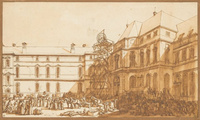
Denon’s special series would not be complete without a record of France’s trophies delivered safely to the Louvre. In Zix’s Arrival at the Louvre of the Grande Armée’s Treasures (fig. 17), a pen drawing with ink wash from 1810, we find Johann Gottfried Schadow’s (1764–1850) Quadriga of Victory (1793), reassembled after its removal from Berlin’s Brandenburg Gate and dismantlement for transport to Paris in twelve crates, alongside the Cupid and Psyche from Denon’s visit to Berlin.[77] Several objects featured in this drawing and the twelve others in Denon’s spoliation series would appear again in the numerous drawings, prints, and watercolors French artists made of the Louvre’s loot-filled galleries during the First Empire. More than a bookend to the Dessins Denon, this final drawing and the interior visions of the museum’s rich displays made in the last five years of the First Empire together signify the attainment of a cultural goal aspired to by proponents of the Revolutionary Wars and by Napoleon Bonaparte, and eventually realized by Denon, the insatiable collector and the First Empire’s most efficient art looter.
A Secondary Narrative
Through the use of shared signifiers of spoliation, such as crates, ladders, piled artworks, and grand exhibition spaces in foreign halls, Denon constructed a thematic visual account of the cultural conquests. As a corpus, these pictures of art confiscation are, in effect, a museum professional’s chronicle of art looting in the guise of collecting in the dawning age of universal museums, the institutional by-products of imperialism that collect and display cultural objects from around the world. The art confiscations read as a secondary or parallel narrative to the battles, sieges, and triumphal entries that would have made up most of Denon’s anticipated recueil of French victories; they were both self-contained and integral to Denon’s larger account of Napoleonic conquests. Had the project been fully realized, the dispersal of pictures of art seizures—with Denon’s portrait cleverly included—among scores of war scenes would have encouraged viewers to form associations between France’s military conquests and its cultural conquests and, more specifically, to link Denon’s achievements in growing the Louvre’s collections from war booty with the martial victories of Napoleon and his most distinguished warriors. And as this study has proposed, Denon’s images presented an orderly, civil, and professional enterprise to transform popular notions of art spoliation from plunder and vandalism into a noble, post-Enlightenment methodology for museum building when led by the First Empire’s premier museum expert.
In the end, however, there would be no recueil. Denon’s mania for amassing drawings—a symptom of what Dupuy has termed an “iconographer’s fever”—thwarted the fulfillment of his objectives.[78] The body of sketches and drawings multiplied, but Denon failed to turn his attention to the engraving stage, and the venture dragged on well beyond the timeline set out in 1806. There is no evidence Denon entertained the possibility of publishing his recueil in installments to subscribers, the approach employed by the editors of Collection complète des tableaux historiques de la Révolution française and one that could have satisfied the Emperor’s demand for an immediate product while supporting the project financially over time. Much to Denon’s consternation, Napoleon eventually lost interest in the endeavor altogether: “If you would only deign, Sire, to take a look at this suite,” Denon begged him in an 1808 letter, but there is no evidence that Napoleon ever acceded to the request.[79] In 1810, Denon made one last plea to prolong his project to the palace grand marshal: “Concerning His Excellency’s request to know when this project will be finished, without comparing myself to Boileau or the Emperor to any other monarch, I will say it like the poet: ‘Great king, cease conquering or I will cease writing.’ An order from the Emperor made me undertake this suite, and only an order from His Majesty will end it.”[80] Denon further defended the progress he had made on his project asserting that “of the sixty modern history paintings exhibited this year, fifty of the subjects are pulled from this collection, and . . . each time the manufactories of the Gobelins or Sèvres is called upon to make something, it is again to this interesting series that they refer.”[81] His pleas were to no avail. The fall of the First Empire in 1815 effectively terminated any hopes for publication of the Dessins Denon, and all that remains today are the preparatory sketches and finished drawings.[82]
Denon continued to carry out his duties at the Louvre into the early Restoration period. His determination to closely observe and precisely relate events carried over to the Allies’ forceful reclamation of confiscated artworks from Paris. In 1815 Denon wrote an outraged account of the actions he witnessed in the waning months of his tenure as museum director: “I saw it as one of the most important and painful duties I had to fulfill to give the public, to whom this museum so fully belonged, a faithful chronicle and the most precise details of the undertakings that led to its dismemberment.”[83] Denon’s reputation as a documentarian would be recalled in later years, as when the Biographie nouvelle des contemporains (New biography of contemporaries) in 1822 invoked Denon’s unfinished Dessins Denon project in a passage that could have been penned by Denon himself: “Mr. Denon followed the emperor on his campaigns in Austria, Spain, and Poland, and drew under his eyes our warriors’ most beautiful military feats; it is in this regard that he deserves a place among the historians of French glory and of the reign of Napoleon.”[84]
Had Denon realized his gambit, the Dessins Denon would have added an important series to the genre of engraved recueils of contemporary history. Instead, it joined the many early modern print projects that lingered in indefinite development and remained beyond the reach (and eyes) of their intended audiences. Nevertheless, the drawings remain informative and meaningful, bringing us closer to understanding Denon as an avid art hunter who passionately championed spoliation as collecting while amassing national and private collections, often in bulk, from subjugated rulers and religious institutions. Denon’s legacy as France’s looter-in-chief is firmly established—not just by his drawings but by his records and correspondence and by the recollections of others. As today’s Western museumgoers and administrators reevaluate universal collections formed from the gains of imperialism and colonialism, the Dessins Denon open a window onto the sort of single-minded ambition that created the conditions with which museums must now contend.
Notes
All translations, unless otherwise noted, are my own.
[1] This study employs the terms “spoliation,” “looting,” “seizure,” and “confiscation” interchangeably. French art historians have traditionally employed more benign nomenclature including “annexation” and “reclamation” to describe the systematic removal of art by French forces from their European enemies during the French Revolutionary and Napoleonic Wars. With increasing attention to cultural property over the past decades, the rising generation of French scholars are all but unanimous in characterizing these events plainly as art looting, and I maintain this practice. See, for example, a selection of titles by Bénédicte Savoy, the preeminent scholar of so-called cultural conquests: Bénédicte Savoy, “The Looting of Art: The Museum as a Place of Legitimization,” in Napoleon’s Legacy: The Rise of National Museums in Europe, 1794–1830, ed. Ellinoor Bergvelt et al. (Berlin: G+H Verlag, 2009), 29–39; and Bénédicte Savoy, Kunstraub: Napoleons Konfiszierungen in Deutschland und die europäischen Folgen (Cologne: Böhlau Verlag, 2011).
[2] Museums known to hold images from the Dessins Denon series include the Musée Vivant Denon in Chalon-sur-Saône, the British Museum in London, the Musée du Louvre in Paris, and the Musée du Château de Versailles. See notes 6 and 9.
[3] See the Appendix for a list of all thirteen known works with looting themes.
[4] Any study pertaining to the French spoliation of European art owes a scholarly debt to Bénédicte Savoy’s groundbreaking publications and lectures. In addition to the works cited in note 1, see especially Bénédicte Savoy, Patrimoine annexé: Les Biens culturels saisis par la France en Allemagne autour de 1800, 2 vols. (Paris: Fondation Maison des Sciences de l’Homme, 2003); Bénédicte Savoy, 1815—année zéro: L’Europe à l’heure des restitutions d’oeuvres d’art, 2019, video series, produced by Collège de France, Paris, https://www.college-de-france.fr/; Bénédicte Savoy, “‘Invaluable Masterpieces’: The Price of Art at the Musée Napoléon,” Journal for Art Market Studies 1, no. 1 (2017): 20–33; Bénédicte Savoy, “Über die Pariser Kunstlandschaft um 1800,” in Napoleons neue Kleider: Pariser und Londoner Karikaturen im klassischen Weimar, ed. Wolfgang Cillessen, Rolf Reichardt, and Christian Deuling (Berlin: G+H Verlag, 2006), 130–44; Bénédicte Savoy, “‘Fiat justitia!’: Les Réclamations allemandes de 1814,” in Les Vies de Dominique-Vivant Denon, ed. Daniela Gallo (Paris: Musée du Louvre, 2001), 2:461–95; and Bénédicte Savoy, “‘Une ample moisson de superbes choses’: Les Missions de Vivant Denon en Allemagne et en Autriche, 1806–1809,” in Dominique-Vivant Denon: L’Oeil de Napoléon, ed. Marie-Anne Dupuy, exh. cat. (Paris: Réunion des Musées Nationaux, 1999), 170–82.
[5] The most significant study of the Dessins Denon is Claudine Lebrun-Jouve’s excellent chapter “Les ‘Dessins Denon’ du Louvre: Un projet politique non abouti ou un dessein personnel?” in Le Livre et l’art: Études offertes en hommage à Pierre Lelièvre, ed. Thérèse Kleindienst (Paris: Somogy, 2000), 353–76. See also Claudine Lebrun-Jouve, “Nicolas-Antoine Taunay (1755–1830)” (PhD diss., Université Paris IV, 1989); and Claudine Lebrun-Jouve, Nicolas-Antoine Taunay (1755–1830) (Paris: Arthena, 2003). According to Lebrun-Jouve, Constant Bourgeois contributed the greatest number of images (fifty in all) to the series, and Taunay provided thirty-two. Lebrun-Jouve, “Les ‘Dessins Denon’ du Louvre,” 359–61; and Lebrun-Jouve, Nicolas-Antoine Taunay. I thank Claudine Lebrun-Jouve for kindly sharing her thoughts on the scope of Denon’s project.
[6] Marie-Anne Dupuy-Vachey, Les Itinéraires de Vivant Denon: Dessinateur et illustrateur manosque (Alpes-de-Haute Provence: Le Bec en l’Air, 2007), 18–19 and no. 90; Marie-Anne Dupuy-Vachey, Question de style: Dessins XVII . . . XIXe s., ed. Pierre Rosenberg, exh. cat. (Manosque: Le Bec en l’Air, 2008), 94–95; and Juliette Barbarin and Marie-Anne Dupuy-Vachey, “Dominique-Vivant Denon (1747–1825) en son musée: Retour sur quatorze ans d’activité,” La Revue des musées de France, no. 1 (2015): 53–54. As Dupuy-Vachey has established, the Musée Vivant Denon in Chalon-sur-Saône holds about twenty examples of the Dessins Denon.
[7] Pierre Lelièvre, “Vivant Denon, Directeur des beaux-arts de Napoléon” (PhD diss., Université de Paris, 1942). On Benjamin Zix’s involvement in the project, see Régis Spiegel, “Benjamin Zix et Vivant Denon: De l’aventure au mythe” (master’s thesis, Université Marc Bloch, 1997); Régis Spiegel, Vivant Denon et Zix, acteurs et témoins de l’épopée napoléonienne (Paris: L’Harmattan, 2002); and Régis Spiegel, “Benjamin Zix, ami et collaborateur de Vivant Denon,” in Dupuy, Dominique-Vivant Denon, 272. Special thanks to Régis Spiegel for sharing his thesis and book with me. On Charles Meynier’s contribution, see Isabelle Mayer-Michalon, Charles Meynier, 1763–1832 (Paris: Arthena, 2008), 205.
[8] In an 1808 report, Denon informed the emperor that he had accumulated 320 drawings to date and that “[l]a collection de ces dessins devient immense.” Vivant Denon to Napoleon Bonaparte, August 15, 1808, AF/IV/1050, folder 4, p. 34, Archives Nationales, Paris, reproduced in Dominique-Vivant Denon, Vivant Denon, directeur des musées sous le Consulat et l’Empire: Correspondance, 1802–1815, ed. Marie-Anne Dupuy, Isabelle Le Masne de Chermont, and Elaine Williamson (Paris: Réunion des Musées Nationaux, 1999), 2:1334.
[9] As Lebrun-Jouve observed, most of the drawings acquired by the Louvre in the nineteenth century pertained to the Italian campaigns, while those that first went to Versailles depicted the German and Austrian campaigns. Lebrun-Jouve, “Les ‘Dessins Denon’ du Louvre,” 354, 371n5.
[10] The Louvre exercised its right of preemption to acquire these additions to the Dessins Denon collection. Didier Rykner, “Le Louvre préempte l’intégralité des dessins napoléoniens chez Ivoire Toulouse,” La Tribune de l’art, September 26, 2019, https://www.latribunedelart.com/.
[11] For the sake of clarity and continuity, this article refers to the Louvre to designate the French national art museum known today as the Musée du Louvre. The Louvre’s name changed several times in the decades after it was established in 1793.
[12] The definitive study of Dominique Vivant-Denon is Marie-Anne Dupuy’s masterly catalogue for the exhibition in 1999 at the Louvre entitled Dominique-Vivant Denon: L’Oeil de Napoléon, which illustrates several of the spoliation images. See Dupuy, Dominique-Vivant Denon, 150–52. My sincere thanks to Marie-Anne Dupuy-Vachey for discussing the Dessins Denon project with me in the context of Denon’s life and work and for assistance locating images.
[13] Official Napoleonic propaganda often took the form of contemporary history painting, a genre Napoleon and Denon encouraged throughout the First Empire. See especially David O’Brien, After the Revolution: Antoine-Jean Gros, Painting, and Propaganda under Napoleon (University Park: Pennsylvania State University Press, 2006); and Annie Jourdan, “Images de Napoléon—un imperator en quête de légitimité,” Modern and Contemporary France 8, no. 4 (2000): 433–44.
[14] See, for example, François Gérard, Arrivée à Paris des chefs d’oeuvre conquis par le traité de Tolentino (Arrival in Paris of the Masterpieces Conquered by the Treaty of Tolentino) (1810), lead pencil, black ink, and ink wash on paper, Musée du Louvre, Paris, RF 51922; and Antoine Béranger and Jean-Charles Nicolas Brachard, after Achille Valois, Arrival in Paris of Artworks Returned from Italy by Napoleon’s Army (1810–14), hard-paste porcelain and gilt bronze, Manufacture Nationale de Sèvres, Paris, MNC 1823.
[15] “vous voudrés bien me permettre d’aller encore une fois sur-le-champ recueillir et constater pour l’avenir les événements de votre histoire.” Vivant Denon to Napoleon Bonaparte, July 14, 1803, AF/IV/1049, folder 2, p. 17, Archives Nationales, Paris, reproduced in Denon, Vivant Denon [. . .] Correspondance, 1802–1815, 2:1248.
[16] “qui illustrent et laissent dans la mémoire les pays qu’elle a parcourus dans ses marches militaires.” Denon to Napoleon, February 26, 1806, AF/IV/1050, folder 2, p. 19, Archives Nationales, Paris, reproduced in Denon, Vivant Denon [. . .] Correspondance, 1802–1815, 2:1302.
[17] “Monsieur Denon sera chargé de l’exécution des dessins et de la gravure d’un ouvrage sur les campagnes d’Italie et d’Allemagne.” Draft decree dated February 26, 1806, which the emperor would approve with minor modifications two days later, in Denon, Vivant Denon [. . .] Correspondance, 1802–1815, 2:1303.
[18] “Apperçu des dépenses pour dessin, gravure, papier, tirage, frais de voyage, et frais de bureau d’une ouvrage sur les campagnes d’Italie et d’Allemagne.” Denon to Napoleon, February 26, 1806, AF/IV/1050, folder 2, p. 19, Archives Nationales, Paris, reproduced in Denon, Vivant Denon [. . .] Correspondance, 1802–1815, 2:1303–4.
[19] In addition, Denon would submit regular progress reports to the palace grand marshal, Géraud Duroc, Duc de Frioul. Vivant Denon, “Projet d’arrêté,” AF/IV/1050, folder 2, p. 21, Archives Nationales, Paris, reproduced in Denon, Vivant Denon [. . .] Correspondance, 1802–1815, 2:1303; and “Décret du 28 février 1806,” AF/IV/193, plaquette (brochure) 1249, Archives Nationales, Paris.
[20] For instance, Lebrun-Jouve suggests that Denon may have made the original sketch for the Parma Academy. Lebrun-Jouve, “Les ‘Dessins Denon’ du Louvre,” 361.
[21] On Denon’s private collection, see Dupuy, Dominique-Vivant Denon, 392–469; Léon-Jean-Joseph Dubois, Description des objets d’arts qui composent le cabinet de feu M. le baron V. Denon. Monuments antiques, historiques, modernes; ouvrages orientaux, etc. (Paris: Imprimerie d’Hippolyte Tilliard, 1826); and Vivant Denon and Amaury Duval, Monuments des arts du dessin chez les peuples tant anciens que modernes: Recueillis par le Baron Vivant Denon, ancien directeur-général des Musées de France (Paris: Didot, 1829).
[22] Denon to Géraud Duroc, November 10, 1810, reproduced in Denon, Vivant Denon [. . .] Correspondance, 1802–1815, 1:671–72.
[23] “Inventaire après décès de Dominique Vivant Denon, Membre de l’Institut, Officier de la Légion d’honneur, Chevalier de l’Ordre de Sainte-Anne de Russie et de la Couronne de Bavière, Membre Correspondant de l’Académie de Calcutta et de plusieurs autres, ancien Directeur Général des Musées Royaux de France,” May 1825, MC/ET/CV/1541, folder “Minutes. 1825, mai,” Archives Nationales, Paris.
[24] The rise in reproductive engraving in eighteenth-century France has been the subject of robust studies, most notably McAllister Johnson’s The Rise and Fall of the Fine Art Print in Eighteenth-Century France (Toronto: University of Toronto Press, 2016); and Cordélia Hattori, Estelle Leutrat, and Véronique Meyer, eds., À l’origine du livre d’art: Les Recueils d’estampes comme entreprise éditoriale en Europe (XVI–XVIII siècles) (Milan: Silvana Editoriale, 2010). More generally, see Antony Griffiths, The Print before Photography (London: British Museum Press, 2016); Ad Stijnman, Engraving and Etching 1400–2000: A History of the Development of Manual Intaglio Printmaking Processes (London: Archetype, 2012); and Victor I. Carlson, David Becker, and John Ittmann, eds., Regency to Empire: French Printmaking, 1715–1814 (Baltimore: Baltimore Museum of Art, 1984).
[25] Print series (distinct from individual prints or illustrated books) about contemporary events were previously less common, but not unknown, in the history of French art. For example, in 1569–70, three French artists in Geneva engraved the Quarante tableaux (Forty Tableaux), a series of forty prints about the sixteenth-century wars of religion. See Jean Perrissin, Jacques Tortorel, and Jacques Le Challeux, Premier volume, contenant quarante tableaux ou histoires diverses qui sont memorables touchant les guerres, massacres, & troubles en France en ces dernières années (Geneva, 1570).
[26] Pierre-Auguste-Marie Miger, Collection complète des tableaux historiques de la Révolution française (Paris: Didot, 1798); and Pierre-Auguste-Marie Miger, Carle Vernet, and Jean Duplessis-Bertaux, Tableaux historiques des campagnes d’Italie depuis l’an IV jusqu’à la Bataille de Marengo (Paris: Auber, 1806). In his official role, Denon would have been aware of the preparation of the latter prior to its publication. Scholars have largely overlooked the significance of recueils in the dissemination of the Napoleonic legend. Annie Duprat provides an important exception with her study “La Construction de la mémoire par les gravures: Carle Vernet et les Tableaux historiques des campagnes d’Italie,” in Les Intéllectuels européens et la campagne d’ltalie, 1796–1798, ed. Jean-Paul Barbe and Roland Bernecker (Münster, Germany: Nodus Publikationen, 1999), 199–231. By far the most thorough analysis of recueils in the revolutionary period is Philippe Bordes, Alain Chevalier, and Claudette Hould, eds., La Révolution par la gravure: Les Tableaux historiques de la Révolution française, exh. cat. (Vizille: Musée de la Révolution Française, 2002). This catalogue offers a window into late eighteenth-century fine-arts publishing operations in France and, by analogy, provides some insight into the challenges Denon faced with his ill-fated project.
[27] “Chaque gravure sera accompagnée d’un discours rédigé par un homme de lettres qui a voyagé dans les différentes parties de l’Italie et de l’armée pendant près de deux ans, et à qui le général BONAPARTE a confié des missions importantes.” Gazette nationale ou le Moniteur universel, June 29, 1799, 1146.
[28] Dominique-Vivant Denon, Voyage dans la Basse et la Haute Égypte pendant les campagnes du Général Bonaparte (Paris: P. Didot, 1802). The volumes were translated into English in 1803, and five subsequent French editions were published between 1802 and 1810. Prior to his acquaintance with Bonaparte, Denon had also published a less successful armchair traveler’s account of his time in southern Italy, Voyage en Sicile (Paris: Imprimerie de Didot l’aîné, 1788), and had penned passages and managed artists’ contributions for the Abbé de Saint-Non’s Voyage pittoresque ou Description des royaumes de Naples et de Sicile, 5 vols. (Paris, 1781).
[29] See Ulrich Leben, “Vivant Denon et le style Empire,” in Gallo, Les Vies de Dominique-Vivant Denon, 2:599–616.
[30] Commission des Sciences et Arts d’Égypte, Description de l’Égypte; ou, Recueil de observations et des recherches qui ont été faites en Égypte pendant l’expédition de l’armée française, 23 vols. (Paris: Imprimerie impériale, 1809–28). Although not as comprehensive or scientifically robust as the Description de l’Égypte, Denon’s prints were nevertheless one of the first broad representations of Egyptian lands and culture seen by a wide European audience, and they launched an “Egyptomania” that inspired new trends in decorating, dress, and architecture in Europe. See Abigail Harrison Moore, “Voyage: Dominique-Vivant Denon and the Transference of Images of Egypt,” Art History 12, no. 4 (2002): 531–49.
[31] There was no systematic seizure of art collections in Egypt as there was in Europe (and Denon’s Travels in Egypt contained no illustrations of plunder), largely because of the British military challenge to the French occupation of Egypt. Nevertheless, Denon and his colleagues were known to have pocketed amulets and other small treasures. See Dupuy, Dominique-Vivant Denon, 396.
[32] “Je faisais la guerre.” Denon, Voyage dans la Basse et la Haute Égypte, 1:xviii. An English-language translation published in New York the following year expressed this with far greater tones of danger and immediacy: “I was frequently in the heat of the action.” Dominique-Vivant Denon, Travels in Upper and Lower Egypt during the Campaigns of General Bonaparte, trans. Arthur Aikin (New York: Heard and Forman, 1803), xviii.
[33] “Le plus souvent sur mon genou, ou debout, ou même à cheval.” Denon, Voyage dans la Basse et la Haute Égypte, 1:xix.
[34] In recent years, Denon scholars have explored the ways Denon’s purportedly factual and disinterested publications concealed an agenda. Of particular note is Michel Dewachter’s contention that Denon prevaricated even in asserting that his diaries from Egypt served as the source text for Travels in Egypt. Michel Dewachter, “Denon, l’Égypte, Champollion et le Louvre: De la légende à la réalité,” in Gallo, Les Vies de Dominique-Vivant Denon, 2:572–73.
[35] “J’avais vu cent choses; mille m’étaient échappées.” Denon, Voyage dans la Basse et la Haute Égypte, 1:xxi.
[36] “J’ai rédigé le moins mal que j’ai pu ce que Votre Majesté m’a dicté avec autant de sagacité que de rapidité; mais n’ayant malheureusement pas été témoin des faits . . . je me trouve réduit à des choses connus et d’une couleur fausse qui me font abandonner à chaque instant un travail que je ne puis trouver digne de vous.” Denon to Napoleon, February 28, 1805, AF/IV/1050, folder 1, p. 11, Archives Nationales, Paris, reproduced in Denon, Vivant Denon [. . .] Correspondance, 1802–1815, 2:1273–74.
[37] “L’histoire des héros exige . . . une espèce d’ensemble dramatique qui ne peut être connu et exprimé que par des témoins oculaires ou par les héros eux-mêmes.” Denon to Napoleon, February 28, 1805.
[38] Denon to Napoleon, February 28, 1805; and Denon to Napoleon, November 13, 1805, AF/IV/1050, folder 1, p. 41, reproduced in Denon, Vivant Denon [. . .] Correspondance, 1802–1815, 2:1286.
[39] “En feuillettant les portefeuilles on verra et l’on croira lire l’histoire de Votre Majesté.” Denon to Napoleon, November 22, 1807, AF/IV/1050, folder 3, p. 20, Archives Nationales, Paris, reproduced in Denon, Vivant Denon [. . .] Correspondance, 1802–1815, 2:1327–28. My emphasis.
[40] On the authority of contemporary representations of events of public importance, see Philippe Bordes, “L’Art et la politique,” in Aux armes et aux arts! Les Arts de la Révolution 1789–1799, ed. Philippe Bordes and Régis Michel (Paris: Biro, 1988), 103–35; and Francis Haskell, History and Its Images: Art and the Interpretation of the Past (New Haven, CT: Yale University Press, 1993), 80–111. See also André Chastel, The Sack of Rome, 1527 (Princeton, NJ: Princeton University Press, 1980).
[41] For an extended discussion of the problematic concept of eyewitnessing in art, see Peter Burke, Eyewitnessing: The Uses of Images as Historical Evidence (Ithaca, NY: Cornell University Press, 2001).
[42] “À Parme,” the committee members wrote, “il est intéressant de reconquérir un tableau du Corrège représentant la Vierge, Saint-Jérôme et une Sainte, ce tableau, fruit du pinceau d’un artiste que l’on peut regarder comme le peintre de la Nature et des Grâces, est l’un des plus beaux ouvrages de ce maître; il est placé dans l’Académie et enfermé dans une boëte.” Comité de Salut Public, May 23, Paris, F/17/1276, folder 15, Archives Nationales, Paris, reproduced in Ferdinand Boyer, “Projets de conquêtes artistiques à Turin et à Parme sous la Convention,” Revue des études italiennes 17, no. 2–3 (1971): 230. The letter also recommended seizing the Bembine Tablet and numerous sculptures and paintings from Turin and rare artifacts from Parma’s libraries.
[43] On May 1, on the heels of victory against the king of Sardinia in Piedmont, General Bonaparte presciently wrote to the French minister in Genoa requesting “une note des tableaux, statues, cabinets et curiosités qui se trouvent à Milan, Parme, Plaisance, Modène et Bologne.” Bonaparte to Guillaume-Charles Faipoult, May 1, 1796, in Napoléon Bonaparte, Correspondance inédite, officielle et confidentielle de Napoléon Bonaparte avec les cours étrangères, les princes, les ministres et les généraux français et étrangères en Italie, en Allemagne et en Égypte, ed. Charles-Théodore Beauvais de Préaud (Paris: C. L. F. Panckoucke, 1918), 1:107.
[44] Conditions de la suspension d’armes conclue entre l’armée française et le duc de Parme, article IV. Reproduced in Le Moniteur universel, May 19, 1796. Bonaparte wrote to the Directory on the day of the peace treaty, boasting, “Ce que nous avons pris à l’ennemi est incalculable. . . . Je vous fais passer vingt tableaux des premiers maîtres, de Corrège et de Michel-Ange.” Bonaparte to Lazare Carnot, May 9, 1796, in Bonaparte, Correspondance inédite, 1:139.
[45] “Je vous enverrai, le plus tôt possible, les plus beaux tableaux de Corrège, entr’autres un Saint-Jérôme, que l’on dit être son chef-d’oeuvre.” Bonaparte to the Directory, published in La Sentinelle, May 18, 1796. When the Duke of Parma offered two million livres for its return, Bonaparte refused, allegedly boasting that the masterpiece would instead adorn Paris for centuries to come. See Marie-Louise Blumer, “La Commission pour la recherche des objets de sciences et arts en Italie (1796–1797),” La Révolution française, no. 87 (1934): 80.
[46] Napoleon was not involved in the 1792–94 campaigns in Belgium and Germany or the corresponding art confiscations. Accordingly, Denon excluded these events from the Dessins Denon.
[47] Denon completed his first trip to Italy for the Dessins Denon in spring and summer 1805, before acquiring formal approval from Napoleon. Vivant Denon, Lettres à Bettine, ed. Fausta Garavini (Arles: Actes du Sud, 1999), 534.
[48] The Louvre’s current attribution is almost certainly wrong. See Mayer-Michalon, Charles Meynier, 205. The 1896 Comte de Durante estate sale catalogue attributed the sketch to Taunay in 1895, but Lebrun-Jouve has challenged this attribution, too. See Lebrun-Jouve, “Les ‘Dessins Denon’ du Louvre,” 361. The manuscript inscription of the name “Hennequin” appears at the top center of the drawing and probably refers to the painter Philippe Auguste Hennequin; this attribution is also soundly rejected. See Charles Meynier [curatorial files], box 1, Département des Arts Graphiques, Musée du Louvre, Paris. The sketch is more likely by one of the artists believed to have accompanied Denon to Italy in 1805 and 1806—Lecomte or Bourgeois—or else by Denon himself.
[49] The French Ministry of Culture records the provenance of Schidone’s painting as “prélevé par les commissaires de la République française à l’académie de Parme et emporté en France en 1796; laissé au Louvre lors des restitutions de 1815.” “La Mise au tombeau,” POP: La Plateforme ouverte du patrimoine, Ministère de la Culture, France, https://www.pop.culture.gouv.fr/.
[50] The drawing is reproduced in Carlo Mambriani, “Dalla corte alla città: Le Trasformazioni della pilotta dagli ultimi Farnese ad oggi,” in Il Palazzo della Pilotta a Parma, ed. Lucia Fornari Schianchi (Parma: Cassa di Risparmio di Parma e Piacenza; Milan: F. M. Ricci, 1996), 42–43. The academy would be destroyed in the nineteenth century. According to Mambriani, modern scholars of Italian architectural history remained unfamiliar with the Parma Academy’s eighteenth-century interior until they discovered Meynier’s refined likeness of it, which subsequently served as a model for the recent reconstruction of the building’s eighteenth-century interior. My thanks to Mambriani for drawing my attention to this matter and for access to his article.
[51] Many of Tinet’s selections were later derided by the dealer and connoisseur Jean-Baptiste-Pierre Lebrun as inferior copies upon their arrival in Paris. Yveline Cantarel-Besson, La Naissance du Musée du Louvre: La Politique muséologique sous la Révolution d’après les archives des musées nationaux (Paris: Éditions de la Réunion des Musées Nationaux, 1981), 2:139, 2:142, and 2:208n1084.
[52] Sometime between May 9 and June 14, Tinet filled four crates with seventeen paintings from Parma and three from Piacenza and placed them temporarily in local storage. He sent an itemized list to Paris of the specific works seized in northern Italy. Several newspapers published the list and highlighted three paintings taken from the Parma Academy: Correggio’s Madonna of Saint Jerome, Schidone’s Entombment of Christ, and an Adoration by “Majolla.” In her rigorous reconstruction of the confiscation timeline, Blumer proposed that Tinet made the selections in Modena on May 22, when the newly appointed commissioners for Italy had only just left Paris. Blumer, “La Commission pour la recherche des objets de sciences et arts,” 78–81. Given the geographic proximity of Parma to Modena, and the close dates of their armistices with France, it is likely Tinet made the selections in Parma around that date. The official commission from Paris arrived in Milan on June 7, 1797—nearly a month after the armistice with Parma—and remained in Lombardy until at least June 10 to examine crates of objects from Modena. On June 14, three commissioners traveled to a storehouse in Piacenza to open the crates from Parma and Piacenza. Those commissioners found five of the works to be of poor quality and left them behind. The paintings from Parma arrived in Paris on August 2, 1797, more than one year later. Le Républicain français, August 4, 1797.
[53] Antoine-Chrysostôme Quatremère de Quincy, Letters to Miranda and Canova on the Seizure of Antiquities from Rome and Athens, trans. Chris Miller and David Gilks (Los Angeles: Getty Research Institute, 2012), “6th Letter,” 115, and “7th Letter,” 116.
[54] On the tradition of spolia victoriae, see Mary Beard, The Roman Triumph (Cambridge, MA: Belknap Press of Harvard University Press, 2007). On cultural property as war spoils and changing attitudes, see Wojciech Kowalski, Art Treasures and War: A Study on the Restitution of Looted Cultural Property, Pursuant to Public International Law (London: Institute of Art and Law, 2012).
[55] The work was originally published in Tableaux historiques de la Révolution française (Paris: Didot, 1802).
[56] France would return the Madonna of Saint Jerome to Parma in 1816. Schidone’s Entombment of Christ remains in the Louvre’s collections, its legal status described as “fruits des conquêtes” in the Joconde database. This record indicates the painting was “prélevé par les commissaires de la République française à l’académie de Parme et emporté en France en 1796; laissé au Louvre lors des restitutions de 1815.” It is noted as being in an “état mediocre,” which may explain why it was never returned to Parma. For a discussion of objects removed from and returned to Parma, see Giuseppe Bertini, “Art Works from the Duchy of Parma and Piacenza Transported to Paris during the Napoleonic Time and Their Restitution,” in Bergvelt et al., Napoleon’s Legacy, 73–90.
[57] Madame de Rémusat (Claire Élisabeth de Rémusat de Vergennes), a companion to Josephine Bonaparte and Dame du palais, wrote in her memoires that French soldiers referred to Denon as the emperor’s huissier-priseur, a sort of hybrid bailiff-auctioneer who followed on the heels of the emperor’s conquests to select objects for confiscation with evident rapaciousness. Claire Élisabeth de Rémusat de Vergennes, Mémoires de Madame de Rémusat, 1802–1808 (Paris: Calmann Levy, 1880), 3:115.
[58] Gazette de France, January 21, 1806.
[59] “digne d’ajouter aux richesses que possède la France.” Journal de l’Empire, December 2, 1806.
[60] “Les menuisiers de Potsdam travaillent sans relâche aux caisses nécessaires pour l’emballage de ces précieux effets.” Journal de l’Empire, December 2, 1806.
[61] Elaine Williamson, “Denon, la presse et la propagande impériale,” in Gallo, Les Vies de Dominique-Vivant Denon, 1:156.
[62] Spiegel has observed that Zix’s clear and detailed drawings supported versions of events reported in the official press. Spiegel, Vivant Denon et Zix, 12. In a similar vein, Katie Hornstein has examined the supporting role mass-market maps played for readers of the Bulletins de la Grande Armée who wanted to learn about the French army’s movements. Katie Hornstein, “The Territorial Imaginary of the Revolutionary and Napoleonic Wars,” in Visual Culture of the Revolutionary and Napoleonic Wars, ed. Satish Padiyar, Philip Shaw, and Philippa Simpson (London: Routledge, 2016), 18–19.
[63] Lebrun-Jouve’s “Les ‘Dessins Denon’ du Louvre” exclusively examined works on the Italian campaigns held by the Louvre, thereby excluding Zix’s drawings of French conquests in Germany, Austria, and Poland. Nevertheless, these fall under the umbrella of the Dessins Denon both thematically and chronologically. For his part, Spiegel, in Vivant Denon et Zix, takes for granted that Zix made these drawings in the course of Denon’s documentary project.
[64] Zix was attached to the infantry of the Army of Helvetia under General Balthasar de Schauenberg, who assigned Zix to the post of Grand dessinateur du Général en chef de l’Armée française en Helvétie. Ferdinand Dollinger, “Le Dessinateur strasbourgeois Benjamin Zix (1772–1811), d’après des documents inédits,” Archives alsaciennes d’histoire de l’art, no. 2 (1923): 197, 211–12.
[65] Zix and Denon left Paris to join the French military campaign in Germany in late September 1806, and together they traveled to Frankfurt, Weimar, Berlin, Potsdam, and other cities before arriving in Kassel in January 1806. Marie-Anne Dupuy, “Chronologie,” in Dupuy, Dominique-Vivant Denon, 503–4. See also Spiegel, Vivant Denon et Zix, 82.
[66] Different scholars have alternately identified the figure standing or crouching a respectful distance behind Denon in several of these images as Denon’s secretary, Perne; Berlin Castle’s chief curator, Jean-Godefroy Rhode; and Zix himself. I am inclined to believe the figure represents a self-portrait by Zix, who accompanied Denon to both locations in 1806 and had developed a warm relationship with his superior. The likenesses closely resemble a self-portrait by Zix reproduced in Dollinger, “Le Dessinateur strasbourgeois Benjamin Zix,” 199.
[67] “M. Denon est pour moi la plus belle de toutes les relations: il m’aime bien et j’ai toujours beaucoup à faire pour lui.” Zix to his parents, June 22, 1806, translated in Dollinger, “Le Dessinateur strasbourgeois Benjamin Zix,” 203. Zix also wrote on November 30, 1806, “M. Denon . . . semble avoir pour moi une sincère et très grande affection,” translated in Dollinger, 207.
[68] Johann Friederich Ferdinand Emperius and Johann Wolfgang Goethe, Remarques sur le vol et la restitution des oeuvres d’art et des livres précieux de Brunswick avec divers témoignages sur les saisies d’art opérées en Allemagne par Vivant Denon, ed. Bénédicte Savoy, trans. Aurélie Duthoo (Paris: La Vouivre, 1999). Savoy comments that in addition to their civility, Denon and other French officials made efforts to lend the seizures an air of legality with the drawing of inventories and the signing of minutes from confiscations. Savoy, Patrimoine annexé, 1:129.
[69] The artist’s initials appear on the base of an overturned bust in the foreground of the drawing. There is a second version, not pictured here, that features slight variations in the artifacts represented: Benjamin Zix’s Vivant Denon au Cabinet des Médailles du château de Berlin, début novembre 1806 (Vivant Denon in the Cabinet of Medals at Berlin Castle, Early November 1806) (ca. 1806–7), pen and brown ink with ink wash, private collection, reproduced in Dupuy, Dominique-Vivant Denon, 150, fig. 142.
[70] Although the full name and identity of the secretary Perne remains a mystery to scholars, Catherine Delmas has traced his occupations from 1794 to 1812. See Catherine Delmas, “Denon Directeur de la Monnaie des Médailles,” in Dupuy, Dominique-Vivant Denon, 281n22.
[71] Daniela Gallo identified many of the artworks surrounding the Denon group in Berlin. See Daniela Gallo, “Benjamin Zix. Vivant Denon au Cabinet des Médailles du château de Berlin, début novembre 1806,” in Dupuy, Dominique-Vivant Denon, 150–51, fig. 142.
[72] “un ample moisson.” Quoted in Savoy, Patrimoine annexé, 1:118.
[73] This work would make a reappearance in Zix’s famous frieze Cortège du marriage de Napoléon et de Marie-Louise d’Autriche dans la grande galerie (Marriage Procession of Napoleon and Marie-Louise in the Grande Galerie) (1810), pen with ink and watercolor, Musée du Louvre, Paris, Mp-4 1832.25.
[74] See “Musées, transport d’objects d’art d’Allemagne en France, budgets (1807–1812),” O/2/842, Archives Nationales, Paris. Savoy has transcribed the Kassel inventories made in early January 1807 and signed by Denon and other agents in Patrimoine annexé, 2:399–419.
[75] The newly discovered illustrations provide context for a small drawing in pen and ink wash, Benjamin Zix’s Denon visitant une galerie d’antiques (Denon Visiting a Gallery of Antiquities) (ca. 1807), whose setting Gallo had previously suggested could be Kassel’s Museum Fredericianum, the collections of the Elector of Saxony, or even the Capitoline Museum in Rome. The recent trove revealed it to be the Museum Fredericianum. Currently in a private collection, Denon visitant une galerie d’antiques is reproduced in Dupuy, Dominique-Vivant Denon (1999), 151, fig. 146.
[76] “parmi lesquels il y en a 100 de premier ordre et très utiles pour remplir les lacunes de la collection du Musée.” Denon to Jean-Jacques-Régis de Cambacérès, June 18, 1809, AF/IV/1675, folder 7(II), Archives Nationales, Paris, quoted in Dupuy, Dominique-Vivant Denon, 152, fig. 149.
[77] There exists a more finished drawing of the arrival of Berlin’s treasures in Paris in a private collection. Jean-Pierre Samoyault has recorded that a porcelain plate was ordered for Napoleon’s “service particulier” with a similar theme, supporting Denon’s assertion that the drawings from this project served the broader interests of French art production. Jean-Pierre Samoyault, “Les ‘assiettes de dessert’ du service particulier de l’Empereur en porcelaine de Sèvres,” Le Souvenir napoléonien 53, no. 369 (1990): 3–4. The porcelain painting is attributed to Jacques-François Swebach, the factory’s premier peintre from 1801 to 1813, and its current whereabouts are unknown.
[78] “[F]ièvre d’iconographe.” Dupuy-Vachey, Les Itinéraires de Vivant-Denon, 15.
[79] “Si vous daignez, Sire, jetter quelque jour un regard sur cette suite.” Denon to Napoleon, August 15, 1808, AF/IV/1050, folder 4, p. 34, reproduced in Denon, Vivant Denon [. . .] Correspondance, 1802–1815, 2:1342.
[80] “Relativement à la demande que me fait Votre Excellence pour savoir quand cette entreprise sera finie, sans me comparer à Boileau et l’Empereur à aucun autre monarque, je vous dirai comme ce poète: ‘Grand roi, cesse de vaincre ou je cesse d’écrire.’ C’est un ordre de l’Empereur qui m’a fait entreprendre cette suite, c’est un ordre de Sa Majesté qui doit y mettre fin.” Denon to Géraud Duroc, November 10, 1810, reproduced in Denon, Vivant Denon [. . .] Correspondance, 1802–1815, 1:671. Nicolas Boileau-Despréaux (1636–1711) was a French poet and contemporary of Louis XIV.
[81] “Je prie Votre Excellence d’observer que, des soixante tableaux d’histoire moderne qui sont à l’exposition de cette année, cinquante des sujets sont tirés de cette collection et que, toutes les fois qu’il est question de faire quelque chose dans les manufactures des Gobelins et de Sèvres, c’est encore à cette suite intéressante que l’on a recours.” Denon to Géraud Duroc, November 10, 1810. Denon’s declaration that his preparatory drawings served as visual resources for history painters engaged in commemorating France’s victories probably had some validity, for Denon was known to make sketches available to artists for the realization of contest submissions and state commissions. See O’Brien, After the Revolution, 160. Retracing Salon paintings to the Dessins Denon, while beyond the purview of this paper, could offer important insight into the drawings’ practical use in service to imperial propaganda.
[82] Although there was a lack of clarity as to who actually owned the Dessins Denon after Denon’s death because of the venture’s unusual financing arrangements, Denon’s estate ultimately retained the collection. See Lebrun-Jouve’s analysis of the arrangement in “Les ‘Dessins Denon’ du Louvre,” 370, 371n10.
[83] “J’ai regardé comme un des devoirs les plus importants et les plus douloureux que j’ai à remplir de donner au public, à qui ce musée a si complettement [sic] appartenu, le journal fidèle et les détails les plus exactes des opérations qui nous ont ammené son démembrement.” Dominique-Vivant Denon, Précis de ce qui s’est passé au Musée royal depuis l’entrée des alliés à Paris (n.d.), reproduced in Denon, Vivant Denon [. . .] Correspondance, 1802–1815, 2:1170.
[84] “M. Denon suivit l’empereur dans ses campagnes d’Autriche, d’Espagne et de Pologne, et a dessiné sous ses yeux les plus beaux faits d’armes de nos guerriers; c’est sous ce rapport qu’il mérite une place parmi les historiens de la gloire française et du règne de Napoléon.” A. V. Arnoult et al., Biographie nouvelle des contemporains ou Dictionnaire historique et raisonné de tous les hommes qui, depuis la Révolution française, ont acquis de la célébrité par leurs actions, leurs écrits, leurs erreurs ou leurs crimes, soit en France, soit dans les pays étrangers (Paris: Librairie historique, 1822), 5:357.